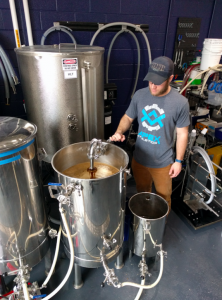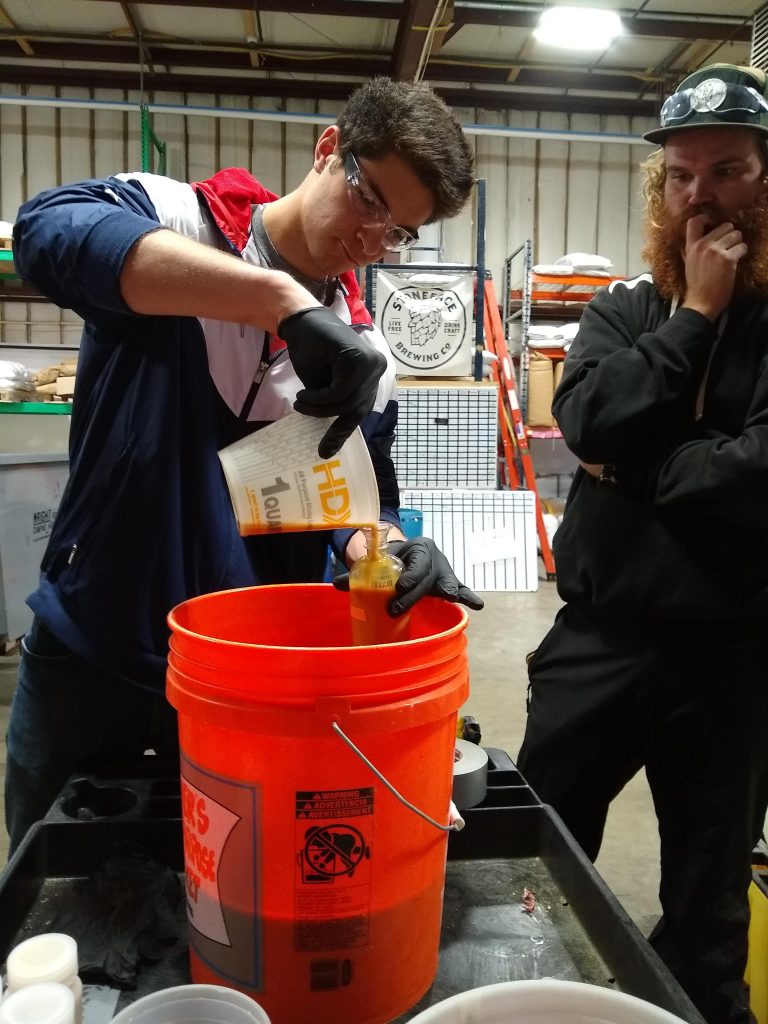By: Abigail Lyon, Piscataqua Region Estuaries Partnership

Brewing at the UNH Brewing Science Laboratory. Photo: Cheryl Parker
The brewing industry in New Hampshire is booming – and as someone who enjoys a local brew, I’m excited! And while it’s likely no surprise that brewing is an energy and water intensive process, brewers are increasingly looking to more sustainable practices that are friendly to both the environment and their bottom line.
Students at the University of New Hampshire Brewing Science Laboratory have recently been working with local breweries to identify opportunities to implement sustainable practices in partnership with the NH Department of Environmental Services. Which got us thinking, what are some ways local breweries are implementing sustainable practices? We were fortunate to sit down with Cheryl Parker, manager of the Brewing Science Laboratory, to learn more.
Abigail: Thank you for meeting with me, Cheryl. To start, what are some ways breweries can increase efficiency, decrease usage, or reuse energy to create a more sustainable system?
Cheryl: There are lots of ways for a brewery to become more sustainable. The most common practice that most brewers have adopted is reclaiming their wort cooling water. Cold water is needed to chill the wort after boiling by using a plate and frame chiller. The water that comes out is quite hot and can be easily captured in a tank for the next day’s brewing and cleaning. But there are a lot more places to save on water, including reusing your cleaning solutions as much as possible by testing them for potency rather than dumping them after each cycle. Brewers can also reclaim rinse water from the final rinse of one fermenter and use it as a first rinse on the next.
“I’ve seen brewers get quite creative in their water savings and every little bit adds up.”
A craft brewer might use 7 to 10 gallons of water for each gallon of beer produced, but macro breweries use only around 3 gallons of water for each gallon of beer. So, there is always room to improve the process. Most of the water a brewer uses needs to be heated first so having an efficient heating system in place will save a lot of energy, but on the often-overlooked end is making sure that pipes and tanks are well insulated. Every change, big and small, adds up! If your brewery is new construction you have lots of opportunities to build for sustainability including in your site selection, building orientation, and materials. But even an established brewery can add insulation, LED lighting, variable frequency drive (VFD) pumps, and more efficient heating and cooling systems. Every situation is different but luckily there are many resources available to help guide you in the right direction.
Abigail: Speaking of resources available, where can breweries and the public learn more about ways to implement sustainable practices?
Cheryl: There are a lot of resources available to learn how to implement sustainable practices. The best part is they are often free! I have a couple in particular that are worth looking at, regardless of your situation. First, the New Hampshire Department of Environmental Services will offer guidance and advice (contact Cynthia Nelson). Their advice is free and confidential, which means you can show them your problems, and they will work with you to fix them. These things may include energy usage or waste and wastewater management. They are also a fantastic knowledge base for other resources. They can point you in the right direction for just about anything energy related. Second is the National Brewers Association (BA), which any independent brewery can be a member of. Along with online resources and manuals for brewery energy efficiency and waste management, they have a dedicated team that will help answer questions. The BA also has a Sustainability Benchmarking Program that any member brewery can register for. This program tracks your utility usage and shows you how you compare nationwide to other breweries of your size. It’s a great way to see how you compare both in sustainability efforts, as well as if you are spending way more than other breweries on certain utilities. It can even highlight serious losses in your system and help you project your energy usage for your planned upgrades and expansions. Starting this year, the NH DES has been given a grant to assist breweries with this benchmarking program. The only criteria are that you be in the state on NH and a member of the BA. My students on the UNH advanced brewing course (SAFS 517) have also been able to get involved in this effort, assisting with data entry and site visits. It’s been a fun project to start and we plan to expand it in the future. Any interested brewery can contact me directly! (see below for contact)
Abigail: Now for the question on everyone’s mind, how can/do breweries balance sustainability and the bottom line?
Cheryl: The best advice I can give is for those building a new brewery is to consider sustainability up front.
“…consider sustainability up front.”

Students taking samples to measure nutrient load from fermenters at Stoneface Brewing Co. The Brewery sidesteams so that it does not go down the drain. Photo: Cheryl Parker
Sometimes a particular item, such as a more efficient chiller or compressor, may cost a bit more, but the long-term savings makes up for it ten times over. So along with planning your recipes and marketing, you need to be analyzing each component of your system, right down to the light bulbs, and what they will cost you to operate long term. Often there are incentives and rebates offered by the utility company or state. Contact them and ask what is available for price matching on energy efficient appliances or free and discounted items such as LED lights. The state of NH has an entire website dedicated to helping businesses get deals on efficient items in both pre- and post-construction. Often your utility company will come and do free assessments for you as well! Some savings cost nothing at all, they just require planning ahead, such as how to lay out your brewhouse to maximize efficiency as far as lighting, distance for forklift travel, and hot water or steam runs. Planning for upgrades strategically will save substantial amounts of money over emergency replacements for key components such as boilers or compressors. Additionally, many breweries have already taken advantage of solar panel incentives and it is absolutely worth checking with your local solar company on what is available for you. The important thing is to be thinking about it and planning during all stages. In fact, it’s been shown by the Brewers Association that even just becoming involved in the Sustainability Benchmarking Program causes a reduction in utility bills. This is simply because it makes the brewer aware of their energy use and that alone results in some cost savings. Planning for sustainability will ultimately save you money as a business owner.
Abigail: Wow it sounds like there are lots of opportunities! My final question, in a saturated market (for breweries) do you find sustainable practices provide a competitive advantage?
Cheryl: Absolutely. We already talked about saving money long term on your utility bills by choosing efficient systems, construction, components, and brewery layouts. With tight margins on beer sales, every penny saved is money toward expansion and new projects. But certainly, the competitive advantage can go beyond that. I find that customers in the craft beer world appreciate a business that considers their environmental impact.
“I find that customers in the craft beer world appreciate a business that considers their environment impact.”
They often are already choosing specifically to purchase a local product that supports a business in their community. They notice things such as the packaging and drive the industry in better directions. In fact, the near disappearance of the plastic rings for craft beer comes to mind. Brewpubs that offer locally sourced food and ingredients have, without a doubt, found highlighting that to their benefit. So, both the visible and hidden sustainability initiatives provide advantages and any brewery can benefit from both.
For more questions about the UNH Brewing Science Laboratory or how to access some of the resources Cheryl mentions in the article above, you can reach her at:
Cheryl Parker
UNH Brewing Science Laboratory
Facebook and Instagram @UNHbrewlab
cheryl.parker@unh.edu
